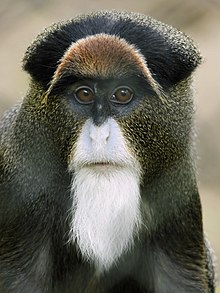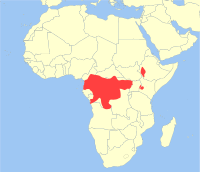De Brazza's monkey
| De Brazza's Monkey[1] | |
|---|---|

| |
| Scientific classification | |
| Kingdom: | |
| Phylum: | |
| Class: | |
| Order: | |
| Family: | |
| Genus: | |
| Species: | C. neglectus
|
| Binomial name | |
| Cercopithecus neglectus Schlegel, 1876
| |

| |
| Geographic range | |
De Brazza's Monkey (Cercopithecus neglectus) is an Old World monkey that gets its name from French explorer Pierre Savorgnan de Brazza. Locally known as swamp monkeys, they are often found in wetlands in central Africa. It is very hard to find due to its good hiding abilities, and so there is not an accurate species count.
This guenon has grey agouti fur with a reddish brown back, black limbs and tail and a white rump. A white stripe runs down its thigh, and an orange crescent-shaped marking appears on its forehead. Its white eyelids match its muzzle and beard. Both sexes have cheek pouches in which to carry food while they forage, and males have a blue scrotum.
De Brazza's Monkey ranges across the swamps, bamboo and dry mountain forests of Angola, Cameroon, Central African Republic, Congo, The Democratic Republic of the Congo, Equatorial Guinea, Ethiopia, Gabon, the Cherangani Hills of Kenya,[3] Sudan, and Uganda.
De Brazza's Monkey lives for about 22 years.[citation needed] It is a shy, territorial monkey that lives in small social groups.[citation needed] At the head of each social group is the strongest male, whose job is to protect his fellow group members.[citation needed]
De Brazza's Monkey communicates with booming sounds, shaking tree branches, and a variety of facial expressions and movements (e.g. shaking its head when stressed out, or nodding with approval).[citation needed]
De Brazza's Monkey is a sexually dimorphic species; males weigh around 7 kilograms, while females weigh around 4.5 kilograms.[citation needed] Babies weigh about 260 grams.[citation needed]
Predators of the De Brazza's Monkey include the leopard, humans, and other primates.[citation needed] However, because of its very good means of protection, De Brazza's Monkey is rarely captured.[citation needed] Among these means of protection are the ability to freeze when alarmed, and the ability to camouflage very well with its surroundings (hence their scientific name Cercopithecus neglectus; neglectus refers to its ability to hide and make it hard for predators to find it).[citation needed]
References
This article includes a list of references, related reading, or external links, but its sources remain unclear because it lacks inline citations. (April 2009) |
- ^ Groves, C. P. (2005). Wilson, D. E.; Reeder, D. M. (eds.). Mammal Species of the World: A Taxonomic and Geographic Reference (3rd ed.). Baltimore: Johns Hopkins University Press. p. 157. ISBN 0-801-88221-4. OCLC 62265494.
- ^ Template:IUCN2008
- ^ Karere G. Mugambi, Thomas M. Butynski, Mbaruk A. Suleman & Wilbur Ottichilo. "The Vanishing De Brazza's Monkey (Cercopithecus neglectus Schlegel) in Kenya". International Journal of Primatology. Retrieved 2008-03-18.
- Maria Petringa, Brazza, A Life for Africa (2006) ISBN 9781-4259-11980
External links

